Well, it wasn’t love at first sight.
But Hoi An sure grew on us rapidly.
We arrived in Hoi An (in the center of the country) and our first impression was of some disappointment. The result of being named a “UNESCO Heritage City”, which is of course a sign of grand architecture and remaining historic authenticity, is that tourists FLOCK.
The resulting crowds are horrific and the first impression was… well… similar to people who visit Granada during the annual Poetry Festival and only visit the “Calzada”. A rookie mistake, as we all know, as it is a far different world 2 streets away, and even more so when not at the height of tourism.
So it was that on day number two, we were able to adjust our aim, find our way past the the hordes of tourists, and find, well, the “other” Hoi An.
And so charming it is, so delightfully multi-layered, that, well, we decided to hold our travel and experience life in Hoi An for a bit.
To be specific, we have found TWO areas that are appealing. Rather different in profile, but both offering a slice of Vietnam life we would like to delve into a bit.
Option One is a place called Thanh Ha. Thanh Ha is 3 km from Hoi An and has a long tradition as a village that became the center of ceramic making in Vietnam about 300 years ago.
To this day, the small village has maintained its tradition of producing fine ceramics and has passed on the knowledge from one generation to the next. So much so, that as Vietnam becomes richer and dilapidated historic homes start to get renovated under strict “historical guidance”, there is only one place where ceramics for traditional floors and roof tiles can be made in the whole country – Thanh Ha.
Interestingly, the village is not only a bee-hive of ceramics activity, it doubles up as a charming fishing village with people making boats, drying fish and old colored boats docked alongside the river.
We have “cruised” the river front of Thanh Ha on our motorcycle, and have initiated chats with locals. One in particular, a young woman who speaks English and to whom we explained we would be delighted to find a house or a room in a house to rent for a few days, with a view to rent perhaps for a month.
While walking the river front with her, Ben points up to a second floor window and says “here, for instance, this would be a nice place for us to live”.
In two minutes, she finds the owner, talks to her about our offer to rent, shows us the upstairs room of the house (where the owner normally sleeps with her baby, and she readily offers to rent the room for $10/night.
If we stay a month, that will give her the money to make some repairs to her house). She warns us, though, that the government may be an issue and that she would confirm the next day her ablity to rent to us, or not, if she gets government approval.
Peta is not particularly looking forward to the “shower by bucket” idea, but the house is super clean and the view unbeatable, and the women (three of them, one a tourist official, her cousin a ceramics maker and the third a massage therapist) are eager to have us move in, as it would be quite a novelty to have foreigners living in the neighborhood, we are told.
Option Two is a place called Tra Que. Tra Que also has historical value. It is an “organic garden and herb village”. In fact, it is the oldest and largest of its kind in all of Viet Nam. Its reputation has grown far and wide, and people around the country know about Tra Que herbs.
Herbs are a key part of Vietnamese cooking, and serious cooks are equally concerned by the extreme freshness of their fish and meat (most Vietnamese women go to the market twice a day to ensure the freshest of ingredients), as they are about the freshness and vitality of their herbs which are integral to most Hoi An dishes.
After all, in Viet Nam, herbs are not only used for their superb tastes and complimentarity with proteins, but also for their beneficial, medicinal value.
Hoi An cooks are reputed for their adeptness at creating meals that have Ying/Yang balance (which of course at this point we know nothing about), and the herbs are an integral part of that. The completely organic herbs are nationally recognized for their flavor and safety, as no chemicals are used in the process of growing them, only seaweed or algae from the nearby De Vong River and Tra Que Pond.
Peta is jazzed about the possibility of living in that village, thinking she could do a deep immersion into organic herb farming, something that would be of great value to us back in Ometepe, Nicaragua, or wherever we may live in the future. Ben, on the other hand, resonates with the fact that this farming community is a sought after destination that offers Vietnamese cooking classes, teaching visitors how to prepare everything you need for Vietnamese gastronomy, starting with making rice paper from scratch. That too would be a good skill to pick up along the way.
And of course, there is An Bang beach, just minutes away, a gorgeous beach. Not deserted, but a lot more “tranquilo” than the first beach we visited, that is a magnet for tourists by day, and Vietnamese by night.
So what will it be? Pottery + Fishing village of Thanh Ha? or Organic Herb farming community + beach near Tra Que? Tune in for the next entry to find out!
For now, let’s zoom back up and spell out the top 10 reasons for selecting the Hoi An region as our first semi-permanent stop (duration unknown) in our Indochinese adventure.
1) River / Boats:
We both love the variety and colors of the old boats on the rivers. Looking forward to some interesting boat trips up and down the river systems that surround Hoi An.
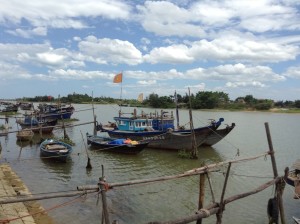 |
| The rivers of Hoi An have a constant flow of a variety of fun colored old wooden boats. |
2) City Architecture and Temples:
Due to Hoi An being a Unesco Heritage City, development is closely controlled and therefore there are no buildings higher than 2 floors high. The combination of Chinese, French, Japanese and Vietnamese traditional construction makes for some unique architecture in one city.
 |
| Hoi An is known for its lanterns which create a warm glow of colors at night. |
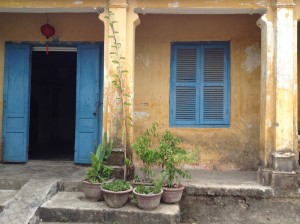 |
| These ochre colored homes were warehouses for when Hoi An was a major trading port between Asia and Europe |
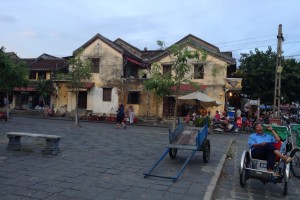 |
| The historic center is closed to cars and is on both sides of the river with a few bridges to cross over. |
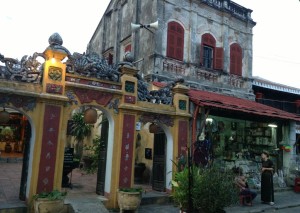 |
| French architecture juxtaposed with remnants of Chinese temples and halls. |
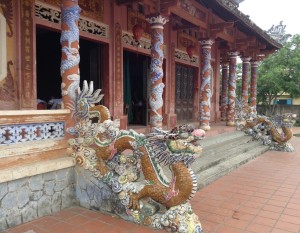 |
| The Chinese had a major presence about 500 years ago and had a thriving “expat” community that drove commerce between Vietnam and China. |
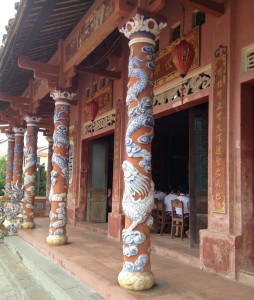 |
| These carved pillars feature blue and white ceramic relief work on burnt sienna background. Gorgeous! |
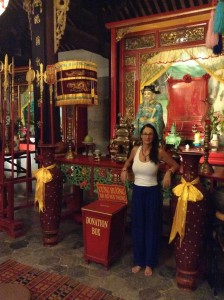 |
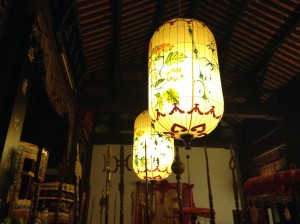 |
| Lanterns were first brought by the Chinese and are still today a major part of the Hoi An culture. |
3) People:
Exceptionally friendly people and with a great sense of humor. It is not difficult to have conversations and interactions, especially with Vietnamese women. One of our first impressions is how direct and “not shy” people are, and often how “touchy” they are.
When Ben was negotiating the price of a tailored shirt, the sales girl slapped his stomach and said “You big Buddha, need many metres of fabric.” They make us laugh a LOT and we certainly make them laugh too. We have mutual surprise and amusement.
So far most people have clearly never heard of either South Africa nor Nicaragua. Given both America and Frances’ deplorable history of war and colonialism, we are not eager to identify with either of those.
Understanding where we are from is a key data point in pricing negotiation and in assessing who we are. So saying French or US, would put us into a financial bracket, not to our advantage either. We are thinking of printing a small map showing where Nicaragua is located. (That will help keep our quoted prices low!)
4) Ease of transport – travel by motorcycle;
We have rented a motorbike which Ben drives and Peta rides. Most fun, very comfy and convenient. Of course at night when people are not working the streets get clogged with motorbikes and driving becomes more challenging. (Parisian driving skills most helpful.) One rather odd observation, is that people drive very slowly, but they also don’t look as they enter traffic from all directions.
5) markets:
Always a favorite place for us in any country. Markets are the heart of the community and where you see real people in daily life.
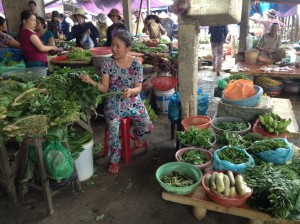 |
| Tons of fresh greens, herbs and vegetables. Quite a lot of items we do no yet recognize…. |
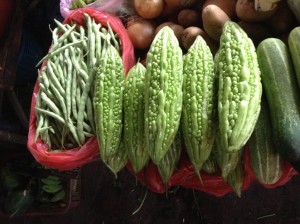 |
| Just found out these are “bitter melons’ ~ How to use these? |
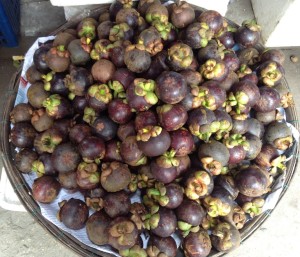 |
| Quickly becoming a firm favorite. Mangosteens with their sweet white soft segments around one small pit. |
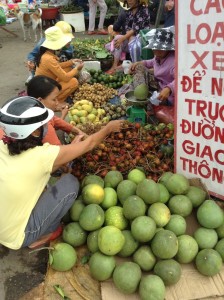 |
| These are the BIGGEST grapefruits ever! Called Pomelo. They make great juice. Not too bitter. |
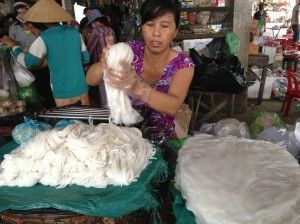 |
| One of the best sights in the market so far. Hand made circles of rice paper on the right and the woman shredding them on the machine to make noodles, right there for each customer. |
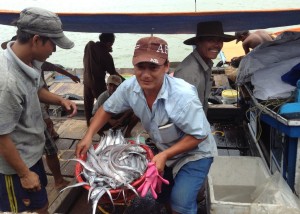 |
| Fresh arrival of some long silver beautiful looking fish. |
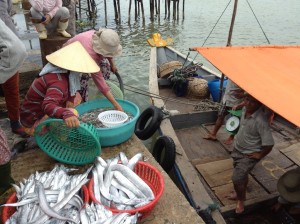 |
| The selection process and bargaining for the best fish, starts here. |
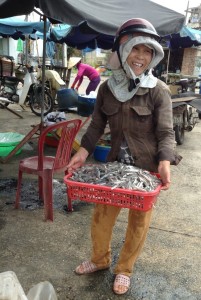 |
| She looks pretty happy with her basket full of fish fresh off the boat. |
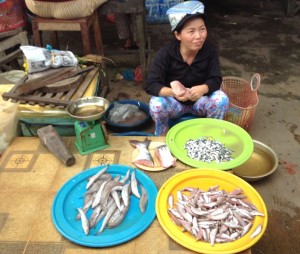 |
| Three types of fish, still alive, for sale. |
6) Food:
If Vietnamese take their food seriously in general, Hoi An is particularly serious about the use of the freshest ingredients and a variety of herbs served with every dish. Below is a sampling.
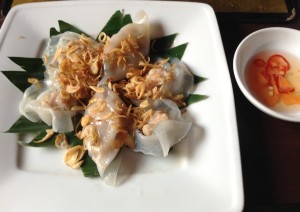 |
| “White Rose”. A specialty of Hoi An. A small shrimp in a delicate soft noodle. Like a dim sum. YUM! |
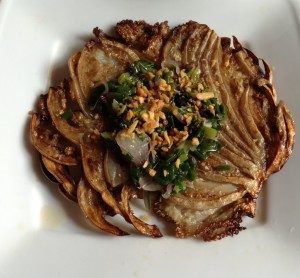 |
| Lightly grilled eggplant with onions, chives, crispy shallots. So good!! |
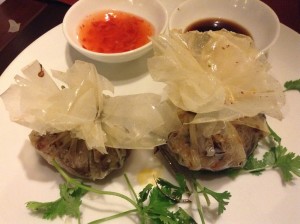 |
| Surprise Hoi Ann package. Fish, and mushrooms inside a crackly rice package with two sauces for dipping. Wow! |
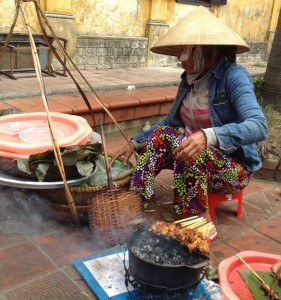 |
| Street skewers of pork cooked over coals and served with large amount of greens. |
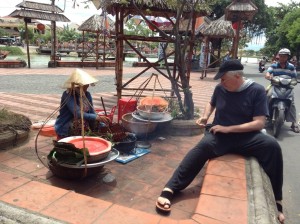 |
| Street food in this case, is often literally eaten curbside. |
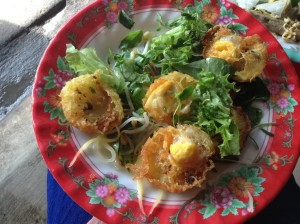 |
| Close up of the crispy shell with soft quail egg, salad greens and sauce on top. Man oh man!! You gotta watch the video below to see her making them. |
7) Potential to design one’s own clothes:
And if all the above was not enough, Bens passion for fashion and design is pushed to an abusrd extreme here. Hoi An is known for its 500 tailor shops that can copy, make, design, sew anything you want and turn it around in 24 hours.
Shoes as well. People come from all over the world just to have clothes made. For instance, wedding parties for the tux, the dress, the bridesmaids dresses etc.
Given the cost of these in the West, the ticket to get here is the only pricy part for most.
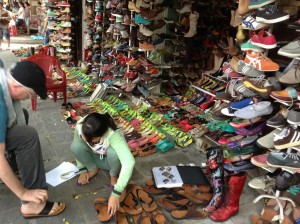 |
| Here is Ben having his feet measured for his first pair of sandals, custom made for $10. |
8) Rice Paddies and Buffalos:
These animals are very peculiar. They are a symbol of the Vietnamese countryside and the beast of burden of choice for rice paddie farmers. Hoi An is surrounded by a lush green blanket of rice paddies. What is most surprising is how extremely responsive they appear to be to human presence. This one below stopped chewing, to look at us.
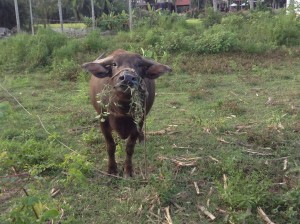 |
| This one is pretty cute. |
9) Beach:
And add to all the above, the fact that Hoi An is on the ocean! There are two lovely beaches to choose from. Cua Dai beach is populated by tourists by day and Vietnamese by early evening.
Vietnamese women go to great lengths to protect their skins from the sun. They do not value suntans, in fact, the exact opposite. They avoid the sun at all costs. Hence they cover up during the day, even wearing socks with their flip flops and jackets with hand covers when on motorcycles.
On the beach they swim in what looks like pajamas to us and they go to the beach only once the sun is going down and then….. its party time!
The beach transforms into a big open air “restaurant” with plastic tables and chairs with little lights on them and as always, delicious Vietnamese food and beer.
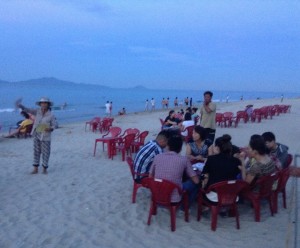 |
| Here dinner al fresco as the sun goes down! |
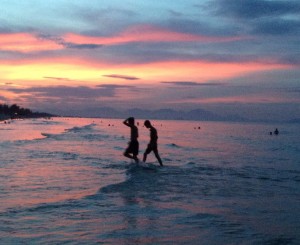 |
| Beautiful sun set draws many to the beach at the end of day for a swim. |
The second beach is An Bang beach. This beach is much less populated, quieter and has a thriving fishing community. The best part is their unique fishing boats, which are made from bamboo and are circular.
The beach has an authentic feel, is not built up at all and yet boasts a handful of low key, attractive restaurants, two of which are French owned and serve high quality well priced French food.
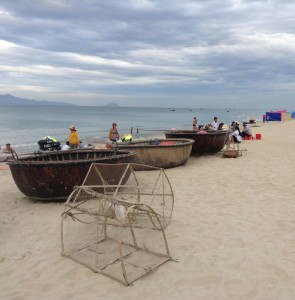 |
| Fishing trap for crabs in front of the bamboo fishing boats. |
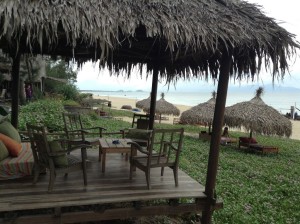 |
| Great vibe at these beach front restaurants with lots of places to relax, and have an upscale experience from the plastic tables and kindergarten size chairs. |
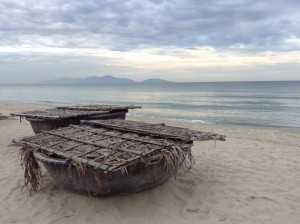 |
| Love these boats!! |
10) Weather:
Much less humid than Hanoi. Very pleasant weather so far. Ok, we hear that the rainy season here has not started yet (sometime around October), and when it does, can be quite relentless.
Apparently last year it rained for six weeks non stop, causing serious flooding issues and constant wetness. So maybe that will be the time to travel to Laos or Thailand.
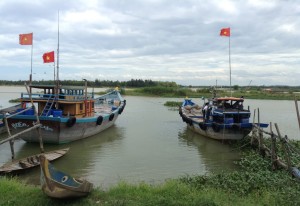
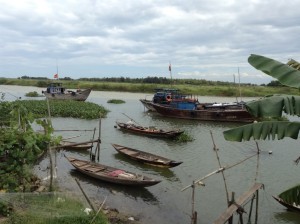
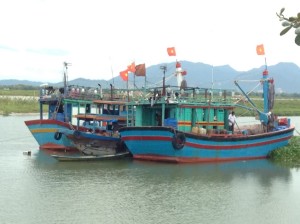
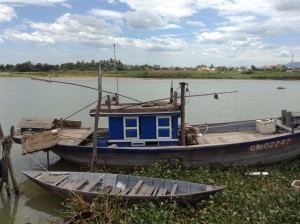
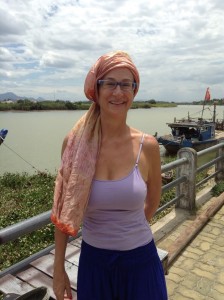

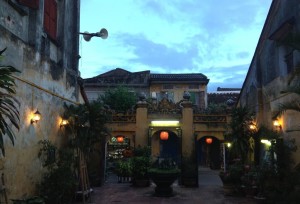
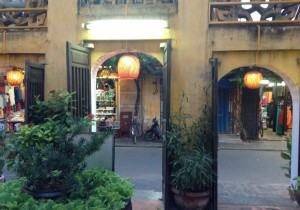
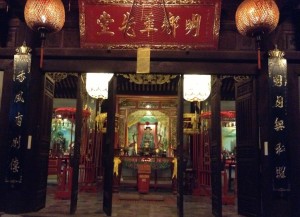
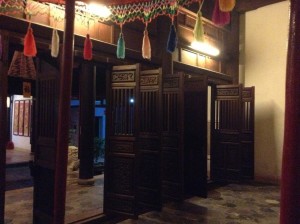

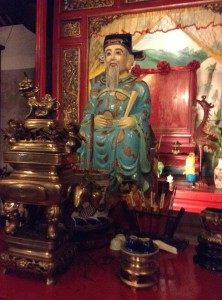
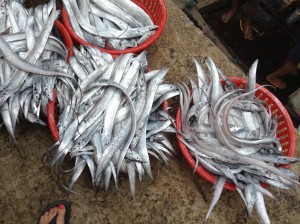
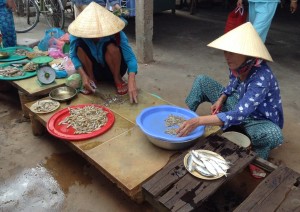
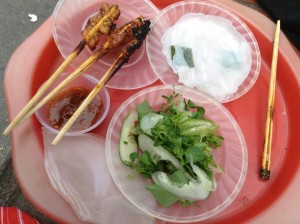
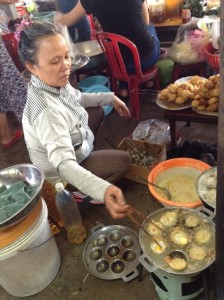
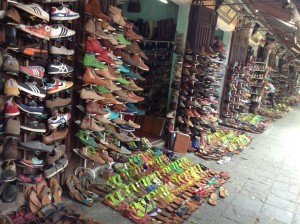
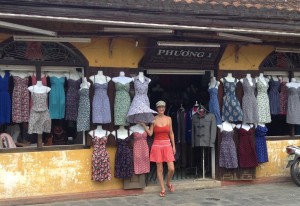
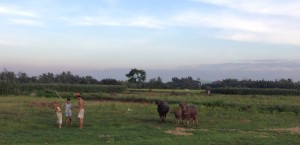
Great Post and exciting developments! Looks like you cant go wrong with either. Cant wait to see pics of the herb farms. Also, can’t figure out what gives the eggplant that ribbed texture, is it a specific type I’ve never seen or something technical?
Thanks! The eggplant is sliced super thin, yet cooked still “connected”, like a fan. I have never seen eggplant cut like that, or cooked in that manner. It was absolutely delicious. Will try to go back and watch them prepare it. We had it in a restaurant called Morning Glory which highlights street food in a restaurant setting. Owned by Ms Vy, who has 3 other restaurants and wrote a cook book called “Taste Vietnam” (will try to send it to you.) 🙂
Wow! All looks and sounds amazing….BSB, remember Mangoustans fruit when we were kids….zzzzz best fruit ever….never saw them again until now…now it makes sense, it is a Vietnamese fruit…duh!!!! Going to a Vietnamese market tomorrow to find some…my faaaaaaaavorite:). I like the idea of the herb/beach home…although both sounds like so much fun….did you ever try the spinach? Heard it was a must?
YES I do remember mangosteens from when were kids. Yum. The river spinach with garlic is delicious.
Holaaaaaaaaaaaaaa!!
I’d go with the beach and the herb village!!!!! Oh man, do I miss Asia and all its delicious food when I see these photo’s! Sending you guys lots of love x
We did indeed! We did not get local authorities permission for the fishing/ceramic combo (Ben’s choice) seeing as it was not a “designated” home stay. SO nice to hear from you! xoxo